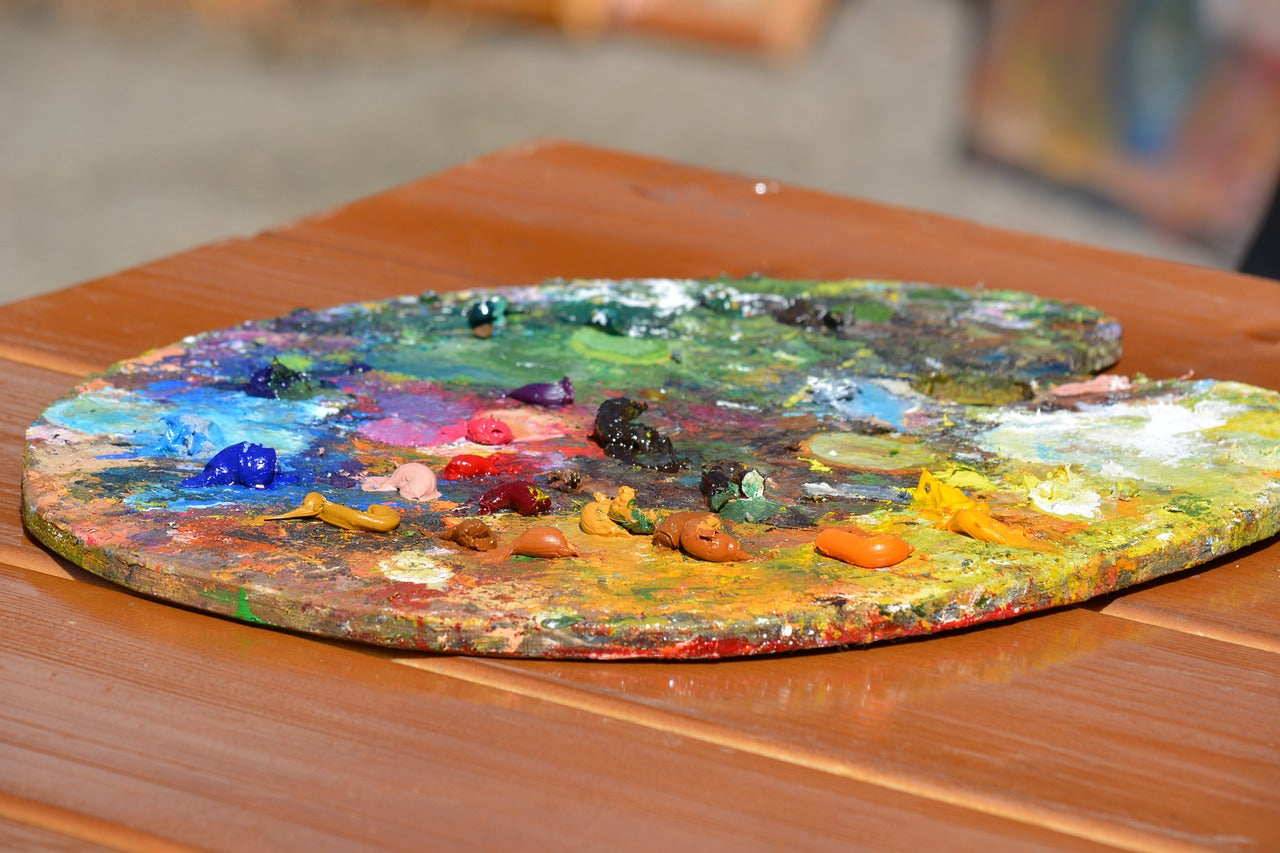A palette board is an essential tool for artists, but it doesn’t have to be just functional it can also be a personal statement of creativity. Customizing a palette board with paints allows artists to add a unique touch to their workspace, making it more inspiring and enjoyable. Whether you want a simple color-coordinated design or an intricate artistic pattern, DIY palette board customization is an excellent way to personalize your tools while experimenting with different painting techniques.
This guide will walk you through everything you need to know about customizing a palette board, from gathering the right materials to mastering basic and advanced painting techniques. By the end, you’ll have a beautifully customized palette board that reflects your artistic style.
Essentials for Palette Board Customization
Before starting, it’s essential to gather all the necessary materials. The right tools will make your customization process smoother and help achieve professional results.
Materials Needed
-
Palette Board: Choose a wooden palette board, as it provides a sturdy surface for painting. Wooden palettes are also more durable and customizable compared to plastic ones.
-
Acrylic Paints: Acrylic paints work best for customizing wood as they are vibrant, fast-drying, and long-lasting.
-
Paintbrushes: Use a variety of brush sizes for different painting effects.
-
Stencils: Stencils help create precise and consistent patterns, especially for those who prefer guided designs.
-
Sandpaper: Lightly sanding the board before painting ensures a smooth finish and better paint adhesion.
-
Painter’s Tape: Essential for clean lines and preventing color bleeding.
-
Sealant or Varnish: Applying a sealant protects the paint from wear and tear, extending the life of your customized palette board.
Selecting the Right Palette Board
When choosing a palette board, consider the following:
-
Size and Shape: Select a size that feels comfortable in your hand and suits your painting style.
-
Wood Type: Hardwoods like maple or birch offer durability, while softer woods are lighter but may not last as long.
-
Surface Texture: A smooth surface is best for paint mixing, but if you prefer texture, opt for lightly textured wood.
Preparing Your Workspace
Creating an organized workspace is key to a smooth customization process. Proper preparation ensures efficiency and minimizes mess.
Setting Up Your Space
-
Clean the Area: Remove any unnecessary clutter to keep the workspace organized.
-
Ensure Good Ventilation: If you’re using strong paints or sealants, work in a well-ventilated area.
-
Use Protective Coverings: Cover your work surface with old newspapers or a drop cloth to avoid paint spills.
-
Keep Lighting in Mind: Good lighting is essential for visibility and precision in painting.
Organizing Tools and Materials
-
Keep Paints and Brushes Handy: Arrange them within easy reach to avoid disruptions while painting.
-
Use Containers for Small Items: Store items like stencils, painter’s tape, and brushes in labeled containers for easy access.
-
Have a Trash Bin Nearby: This helps with quick disposal of used materials.
Basic Techniques for Palette Customization
Even if you are new to painting, mastering some basic techniques will help you create an impressive design.
Step-by-Step Guide for Beginners
-
Prepare the Surface: Lightly sand the palette board and wipe off dust with a damp cloth.
-
Apply a Base Coat: Use a neutral color or your favorite shade as the background.
-
Plan Your Design: Sketch out rough ideas or use stencils to guide your painting.
-
Start Painting: Apply thin layers of paint, allowing each layer to dry before adding another.
-
Refine the Design: Use fine brushes for detailing and a dry brush for shading.
-
Let It Dry Completely: Before applying a sealant, ensure the paint is fully dry.
Techniques for Smooth Color Transitions
-
Blending: Mix colors directly on the board for seamless transitions.
-
Dry Brushing: Use a dry brush with minimal paint for textured effects.
-
Sponging: Dab a sponge in paint to create a mottled texture.
Advanced Decorative Techniques
For those who want to take their customization to the next level, try these advanced techniques:
Stenciling
-
Secure the stencil with painter’s tape.
-
Use a sponge or stencil brush to dab paint onto the surface.
-
Carefully lift the stencil to reveal the pattern.
Masking Tape for Geometric Patterns
-
Apply painter’s tape in desired geometric shapes.
-
Paint over the exposed areas.
-
Remove the tape carefully once the paint dries.
Adding Texture
-
Use a palette knife for a thick, textured effect.
-
Experiment with layering colors for depth and dimension.
Thematic Decoration Ideas
Customizing a palette board can be more exciting when following a specific theme. Whether you prefer a simple, modern aesthetic or a bold, artistic expression, here are a few creative ideas to try:
-
Minimalist Design: Stick to neutral shades, soft gradients, and simple patterns for a sleek, modern look. Adding subtle textures or monochrome tones can enhance the effect.
-
Nature-Inspired: Use greens, browns, and earth tones to reflect natural beauty. Incorporate leaf prints, tree silhouettes, or even floral patterns for a more organic feel.
-
Abstract Art: Experiment with bold colors, dynamic brushstrokes, and splatter effects. Layer different hues and textures to create depth and movement.
-
Seasonal Designs: Customize your palette board with winter, summer, spring, or fall-themed colors. Add snowflakes or icy blues for winter, vibrant yellows and oranges for summer, pastel blooms for spring, or warm reds and golds for autumn.
-
Vintage Aesthetic: Use muted pastels, distressed painting techniques, or antique washes to create a rustic, old-world charm. Try crackle paint for an aged look.
-
Bohemian Style: Incorporate free-spirited, colorful patterns, mandala designs, or tribal motifs to create a vibrant, artistic touch.
Maintaining and Sealing Your Palette
After putting effort into customizing your palette board, protecting it ensures longevity and durability.
Sealing the Palette Board
-
Apply a thin coat of acrylic sealant or varnish to protect your artwork from wear and tear.
-
Let it dry for at least 24 hours before use to ensure proper adhesion.
-
For added protection, apply multiple layers, allowing each to dry completely before adding another.
Cleaning and Maintenance
-
Wipe the palette board with a damp cloth after each use to remove excess paint and prevent buildup.
-
Avoid excessive water exposure to prevent warping, peeling, or fading.
-
Store in a cool, dry place away from direct sunlight to preserve the vibrancy of colors.
-
If using oil paints, consider applying a thin layer of linseed oil to keep the surface conditioned.
Troubleshooting Common Issues
Even with careful painting, some issues may arise. Here’s how to fix them:
-
Problem: Paint is peeling off.
Solution: Ensure the board was properly sanded, cleaned, and primed before painting. Use a quality primer or gesso. -
Problem: Colors are blending too much.
Solution: Let each layer dry completely before adding another to maintain clarity between colors. -
Problem: Paint appears streaky.
Solution: Use smooth, even strokes with a high-quality brush or sponge applicator. Avoid overworking the paint. -
Problem: The board absorbs too much paint.
Solution: Apply a primer or a base coat before painting to create a sealed surface. -
Problem: Paint cracks after drying.
Solution: Use flexible acrylic paint or mix in a bit of acrylic medium to prevent cracking.
Gallery of Inspirational Examples
Looking for inspiration? Here are some stunning customization ideas to spark your creativity:
-
Bold Abstract: Play with vibrant color splashes, expressive strokes, and layered textures for a contemporary look.
-
Floral Motifs: Hand-paint delicate flower patterns, vines, or even watercolor-style botanical designs for a soft, artistic touch.
-
Classic Wood Finish: Preserve the natural beauty of the wood by using a transparent stain or a subtle, polished finish with minimal design.
-
Geometric Patterns: Use clean lines, sharp angles, and contrasting colors to create a modern and structured aesthetic. Try triangles, hexagons, or chevron patterns.
-
Inspirational Quotes: Paint motivational words or artistic typography on your palette board to create a personalized and meaningful piece.
-
Ombre Gradient: Blend colors smoothly from dark to light for a striking yet simple design.
Customizing a palette board is a great way to express creativity while adding a unique touch to your art space or home decor. Whether you prefer a modern, rustic, or eclectic style, the possibilities are endless!
(Source: @simplystephanieart)
Customizing a palette board is a rewarding way to add personality to your workspace. Whether using simple techniques or more advanced designs, the end result is a unique and inspiring tool for your creative process. The right products can make a difference in customization projects. Angelus Direct provides high-quality paints, brushes, and finishing products that ensure a professional-looking and long-lasting result.
FAQs
1. What are the best color combinations for a vibrant palette board?
Complementary colors like blue and orange or monochromatic schemes work well.
2. How can you quickly customize a palette board when time is limited?
Use spray paints and stencils for fast yet professional results.
3. How can beginners get started with palette board customization?
Start with simple designs and gradually experiment with advanced techniques.
4. What are the best practices for cleaning and maintaining custom palette boards?
Clean immediately after use and apply a sealant for protection.
5. Can I repurpose an old palette board?
Yes! Sand it down, repaint, and seal it for a fresh look. For the best results in customizing and protecting painted surfaces, Angelus Direct offers premium acrylic paints, sealants, and brushes tailored for long-lasting customization.

